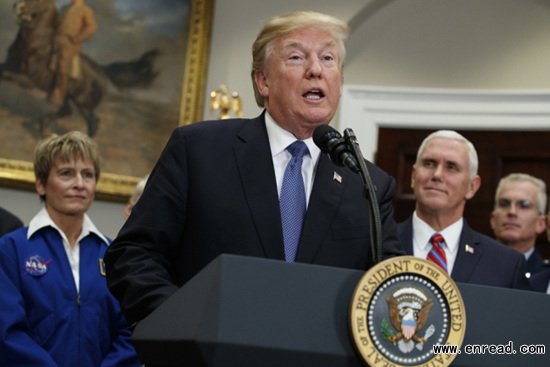特朗普签署太空政策指令 重返月球
时间:2017-12-12 08:45:57
(单词翻译:单击)
U.S. President Donald Trump1 on Monday signed his administration's first space policy directive, formally directing the U.S. space agency NASA to send astronauts back to the moon and eventually Mars.
美国总统特朗普周一签署任职后第一份太空政策指令,正式要求美国宇航局NASA将宇航员重新送上月球并最终到达火星。

"This time, we will not only plant our flag and leave our footprint," Trump said at a White House ceremony.
"We will establish a foundation for an eventual2 mission to Mars, and perhaps, someday, to many worlds beyond," he said.
Trump offered no specific timeline during his four-minute speech.
The Space Policy Directive 1, as it's called, was based on recommendations of the National Space Council, which Trump directed to reestablish in June to advise and help implement3 his space policy with exploration as a national priority.
The council was first created in 1989 during the administration of President George H.W. Bush but later disbanded in 1993 under President Bill Clinton.
It marked a return to the vision of President George W. Bush, whose Constellation4 program aimed to return astronauts to the moon by 2020 and then go on to Mars.
However, Constellation was cancelled in 2010 by then-President Barack Obama, on the grounds that Americans "have been there before" and that "there's a lot more of space to explore."
Instead, Obama said the United States should start by sending astronauts to an asteroid5, a controversial plan known as Asteroid Redirect Mission, which was scrapped6 earlier this year by the Trump administration.
"Since the beginning of his administration, President Trump has taken steps to refocus NASA on its core mission of space exploration," Deputy White House Press Secretary Hogan Gidley said in a statement earlier Monday.
"He will change our nation's human spaceflight policy to help America become the driving force for the space industry, gain new knowledge from the cosmos7, and spur incredible technology," Gidley said.
点击 收听单词发音
收听单词发音
 收听单词发音
收听单词发音
1
trump

|
|
| n.王牌,法宝;v.打出王牌,吹喇叭 | |
参考例句: |
|
|
|
2
eventual

|
|
| adj.最后的,结局的,最终的 | |
参考例句: |
|
|
|
3
implement

|
|
| n.(pl.)工具,器具;vt.实行,实施,执行 | |
参考例句: |
|
|
|
4
constellation

|
|
| n.星座n.灿烂的一群 | |
参考例句: |
|
|
|
5
asteroid

|
|
| n.小行星;海盘车(动物) | |
参考例句: |
|
|
|
6
scrapped

|
|
| 废弃(scrap的过去式与过去分词); 打架 | |
参考例句: |
|
|
|
7
cosmos

|
|
| n.宇宙;秩序,和谐 | |
参考例句: |
|
|
|
- 上一篇:中国空军巡查巴士海峡和宫古海峡
- 下一篇:普京:俄大选不会影响中俄关系
©2005-2010英文阅读网




